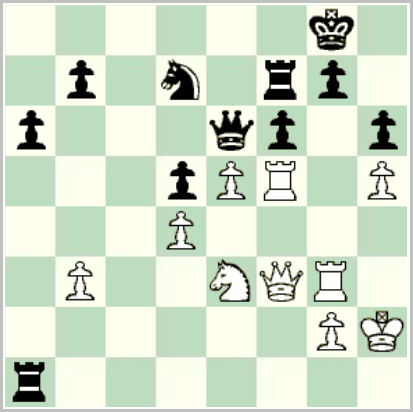The recent posts on the game Oliff-Keogh prompted me to look up the details of the main event with which it was associated, the 1964 Irish championship.
That year’s event suffered several problems that turned it into one of the least memorable championships. It was planned as a 10-player all-play-all, a format that has been used many times for the event. But in this case one of the drawbacks manifested itself: several late withdrawals threatened the viability of the entire event, and it was only by drafting the London player R. W. O’Brien from the Open that it was possible to hold an 8-player all-play-all. Furthermore there were really only two main competitors, the defending champion Wolfgang Heidenfeld and the even-more-veteran Brian Reilly. In the event Heidenfeld won their individual game and cantered home to his third title. At the time the consensus was that the championship was ‘sub-standard’.

31… ?
Only one game seems to survive from the event (but see next post), the second round encounter between Heidenfeld and O’Brien. The critical point is shown in the diagram. Let’s leave this as an exercise: how would you evaluate this position with best play? Answer in a few days.
A full tournament report has also been uploaded.
[Update, February 9, 2016:] See comment for answer to the question posed above.

The game continued 31… fxe5? 32. Rxf7 Qxf7 33. Nf5, winning for White. The finish was 33… Kh8 34. Rxg7 Qe6 35. Qg4 Nf6 36. Rh7+! 1-0.
The reports in the Irish Times and BCM gave this as a straightforward case of an emphatic win. But in fact Black is fine in the diagrammed position. After 31… Rc1!, White has nothing better than 32. Ng4 (32. Nxd5? fxe5 with a clear advantage to Black), when 32… Kh8 33. Nxh6!? gxh6 34. Rg6 Rc6 is unclear/= and nothing more concrete seems available.
White’s last move, 31. Qf3?, turns out to have been a mistake. This is one of the occasions where the attacker is better off trading queens: after 31. Rf4! White wins significant material.